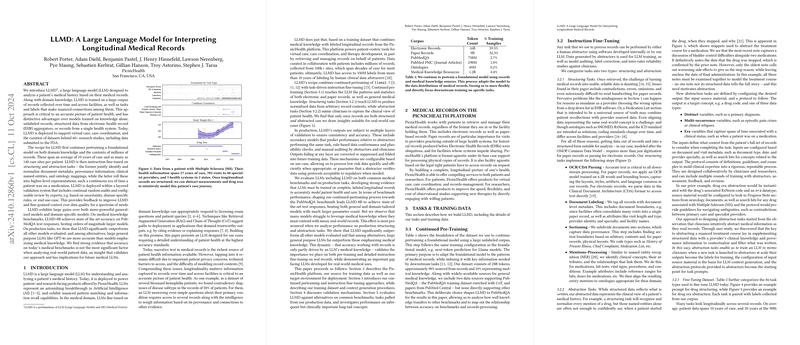Analyzing Longitudinal Medical Records Through a Specialized LLM
This essay provides a detailed overview of the paper titled "LLMD: A LLM for Interpreting Longitudinal Medical Records," focusing on the methodologies, results, and implications in the field of medical AI. The paper presents an LLM, LLMD, tailored specifically for interpreting extensive medical histories through patient records.
Overview of LLMD's Methodology
The paper outlines a two-stage training approach for LLMD. Initially, LLMD undergoes continued pre-training on a blend of domain-specific knowledge and a substantial corpus of medical records. This corpus comprises electronic and paper records sourced from numerous facilities, representing an average patient history spanning a decade. This phase aims to adapt the foundational model to the unique data patterns intrinsic to medical documentation.
Subsequently, the model is fine-tuned through task-specific instruction, focusing on structuring and abstraction tasks. Structuring involves normalizing document metadata and clinical named entities, while abstraction tasks synthesize higher-level representations, such as identifying medication eras. This bifurcation supports LLMD's ability to draw actionable insights from complex, real-world data.
Numerical Results and Comparative Analysis
LLMD-8B demonstrates substantial gains over more generalized models and domain-specific ones on medical knowledge benchmarks. Notably, it achieves state-of-the-art accuracy on the PubMedQA benchmark, surpassing larger models despite its relatively smaller parameter count. This highlights the effectiveness of LLMD’s training regimen in leveraging both medical records and domain knowledge to produce accurate outputs.
In practice, LLMD significantly outperforms on production tasks, underscoring that benchmark accuracy does not necessarily translate to real-world efficacy. This is evident in LLMD’s performance on nuanced tasks requiring interpretation of longitudinal data, where it consistently provides accurate results, often superior to large general models like GPT-4o.
Implications and Future Directions
The research illustrates that while large general-purpose models possess inherent advantages, they struggle without alignment on specific domain data. LLMD’s approach of incorporating labeled, longitudinal datasets proves crucial for accurate real-world application. The importance of structuring and abstraction in aligning LLM capabilities with practical needs offers a roadmap for developing future medical LLMs.
For medical AI, this work implies a shift towards more specialized models trained on comprehensive datasets, facilitated by robust validation frameworks. This ensures the models not only understand medical knowledge but also apply it effectively to patient care scenarios.
Challenges such as handling long-tail data underscore the need for adaptive learning strategies. The authors address this by implementing task decomposition and context generation strategies, yet emphasize that enhanced datasets would further mitigate performance discrepancies.
Conclusion
LLMD exemplifies the evolution of LLMs toward domain-specific expertise, particularly in interpreting multifaceted medical data. This paper’s findings advocate for expanding training datasets and developing specialized validation systems to elevate the model’s practical efficiency. By aligning technical methodologies with patient care needs, LLMD stands as a pivotal advancement in medical informatics, fostering improved patient interactions and contributing substantively to medical research and treatment development.
